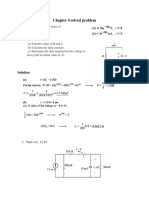Tutorial Questions
Uploaded by
chefrederick01Tutorial Questions
Uploaded by
chefrederick01March 3, 2018
Sequential Switching
Whenever there is more than just one switching action involved in the circuit, we are
Tutorial
talking about sequential switching. If n is the number of switching actions in the circuit,
we will be looking at n+1Electrical
di↵erent and
circuits to analyse.
Electronic Engineering I
Week 6
Example:
Both switches have been on for a very long time.
p
We define !d = ↵2 !02 as the damped radian frequency.In this case
↵t ↵t
v(t) = B1 e cos(!d t) + B2 e sin(!d t)
We can also start from the way we defined the overdamped response
a)Find iL (t) for 0 t 35 ms
Figure 1
e (↵+js!
v(t) = AiL1 (t)
b)Find for t d )t 35
+A ms 2e
(↵ j!d )t
= e ↵t ((A1 + A2 ) cos(!d t) + j(A1 A2) sin(!d t))
c)What percentage of the energy stored in the inductor is dissipated on the 18⌦ resistor?
Problem
Note that 1: A1 + A2 = B1 and j(A1 A2 ) = B2 . Both B1 and B2 are real since A1 and
AAnswers:
2 are complex conjugates. The intermediary step used in the above equation to derive
Inthe
Figure
a)When 1 the
bothswitches
underdamped switches
response have
have been
from
been onon
the fora avery
verylong
overdamped
for long
formtime.
of the
time, the solution
inductorisacts
using
as Euler’s
a short
formula e j! = cos ! + j sin !.
circuit. In this case, the 18⌦ resistor will be shorted out of the circuit. The equivalent
a)To
Find iL(t)
find
circuit B1for
will 0 ≤Btlike
and
look 2≤ 35
, we ms
solve the system
this:
b) Find iL(t) for t ≥ 35 ms
v(0+ ) = V0 = B1
c) What percentage of the energy+ stored in the inductor is dissipated on the 18Ω resistor?
dv(0 ) iC
= = ↵B1 + !d B2
dt C
↵ is also called damping factor.
Problem 2:
Example:
Given that V0 = 0 and I0 = 12.25mAFigure 2
a)Calculate the roots of the equation.
dv
b)Calculate v and for t = 0+
dt
c)Calculate v(t) for t 0
Given that
d)Plot V0 for
v(t) = 00and
tI0=11ms
−12.25mA in Figure 2:
a) Find the poles of the circuit (i.e. the roots of the characteristic
Answers: q polynomial).
106 106
a)We have ↵ =
b) Calculate v2RC
1
=
and dv/dt for t = 0 +
= 200 rad
sec and ! 0 = p 1
= = 103 rad
sec . Since
2(20000)(0.125) LC p8·0.125 p
!0c)> Calculate
↵, we canv(t) forfind
also t ≥ 0the damped radian frequency !d = !02 ↵2 = 100 96 =
rad
979.8 Plot. We
d) sec v(t) will
for 0have
≤ t ≤that
11ms
rad
s1,2 = 200 ± j979.8
sec
b)To find v(0+ ) , we are already given the initial voltage across the capacitor V0 = 0. To
You might also like
- 3.EE252 - SECOND - ORDER - CIRCUITS - Lectrure 33No ratings yet3.EE252 - SECOND - ORDER - CIRCUITS - Lectrure 3356 pages
- Circuit Analysis IV Assignment - PDF CHNo ratings yetCircuit Analysis IV Assignment - PDF CH10 pages
- EE 131 2nd Problem Set SY 2017-2018 1st SemNo ratings yetEE 131 2nd Problem Set SY 2017-2018 1st Sem1 page
- Melbourne School of Engineering ELEN30009 Electrical Network Analysis & Design Semester 1, 2017No ratings yetMelbourne School of Engineering ELEN30009 Electrical Network Analysis & Design Semester 1, 201734 pages
- Natural Response: ECE 3620 Lecture 2 - Second Order SystemsNo ratings yetNatural Response: ECE 3620 Lecture 2 - Second Order Systems5 pages
- L-3 Transient Response of Second Order Circuits (Natural Resopnse)No ratings yetL-3 Transient Response of Second Order Circuits (Natural Resopnse)64 pages
- L6 - Transient Response of Second Order (Natural Response)No ratings yetL6 - Transient Response of Second Order (Natural Response)52 pages
- EE 42/43/100 Introduction To Digital Electronics: Review of Ch. 4-7.3 7/19/13No ratings yetEE 42/43/100 Introduction To Digital Electronics: Review of Ch. 4-7.3 7/19/1343 pages
- Tutorial 4 (07-02-2024) - 240208 - 153642No ratings yetTutorial 4 (07-02-2024) - 240208 - 1536426 pages
- Tutorial Sheet 1 (DC Networks & Transients)No ratings yetTutorial Sheet 1 (DC Networks & Transients)2 pages
- Question With Is Optional To Solve But Recommended: HW7 ch8No ratings yetQuestion With Is Optional To Solve But Recommended: HW7 ch82 pages
- L7 - Transient Response of Second Order (Forced Response)No ratings yetL7 - Transient Response of Second Order (Forced Response)44 pages
- Electric Circuits 10th Edition Nilsson Solutions Manual pdf download100% (2)Electric Circuits 10th Edition Nilsson Solutions Manual pdf download70 pages
- Circuit Theory ECT1016 Assignment (05-06)No ratings yetCircuit Theory ECT1016 Assignment (05-06)3 pages
- ELL 100 Introduction To Electrical Engineering: L 12: T R S - O C (F R)No ratings yetELL 100 Introduction To Electrical Engineering: L 12: T R S - O C (F R)45 pages
- Solving The Second Order Systems: ST Exp A T INo ratings yetSolving The Second Order Systems: ST Exp A T I28 pages
- ECTE202_Week2_Lecture Winter 2025 WorkshopNo ratings yetECTE202_Week2_Lecture Winter 2025 Workshop40 pages
- Student Solutions Manual to Accompany Economic Dynamics in Discrete Time, secondeditionFrom EverandStudent Solutions Manual to Accompany Economic Dynamics in Discrete Time, secondedition4.5/5 (2)
- SDN & NFV in 5G: Advancements and ChallengesNo ratings yetSDN & NFV in 5G: Advancements and Challenges5 pages
- Understanding LLDP, LLDP-MED, and Wired Location ServiceNo ratings yetUnderstanding LLDP, LLDP-MED, and Wired Location Service12 pages
- Technical Note: Bypass Capacitor Selection For High-Speed DesignsNo ratings yetTechnical Note: Bypass Capacitor Selection For High-Speed Designs8 pages
- FCBC / Smps Power Plant MODEL DY 6350 (48V/37.5A)No ratings yetFCBC / Smps Power Plant MODEL DY 6350 (48V/37.5A)1 page
- Precision, 4-Channel/Dual 2-Channel, Low-Voltage, CMOS Analog MultiplexersNo ratings yetPrecision, 4-Channel/Dual 2-Channel, Low-Voltage, CMOS Analog Multiplexers12 pages
- Illuminator Series E: Uninterruptible Power System Single Phase Systems 1.5kVA To 16.7kVANo ratings yetIlluminator Series E: Uninterruptible Power System Single Phase Systems 1.5kVA To 16.7kVA2 pages
- What Are Hard Faults Per Second?: - Hard Fault vs. Page FaultNo ratings yetWhat Are Hard Faults Per Second?: - Hard Fault vs. Page Fault2 pages

























































































